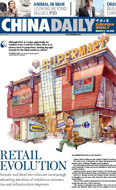Center
Retail evolution
Updated: 2011-03-04 10:17
By Andrew Moody and Hu Haiyan (China Daily European Weekly)
The government is keen to make use of the Yangtze River, which actually starts at Yibin on its way to Shanghai some 1,700 km away, to transport goods and is building a new port to develop shipping.
"Distribution is a problem for us and the government has been helpful with setting up a third party distribution network. Walmart coming here has also led to a more professional local distribution sector emerging," adds Wu.
Although clearly less developed than other parts of China, retail has still benefited by rising local incomes.
"We can detect that over the past two or three years. Increased purchasing power has meant we have had to adjust what we stock and add some more expensive lines," adds Wu.

Many find it difficult to comprehend how far retail has developed in Yibin since the late-1970s when China opened up to the world. Retail sales volume in 2010 of 31.61 billion yuan was actually 93 times that of 1978 at just 33.6 million yuan.
Wang Xuehui, the founder of Lv Yuan, who began selling products such as Wrigley's chewing gum 20 years ago, says it is a completely different ball game.
"There was a scarcity of foreign products and the mark-up was quite high. It was a very much a sellers' market. Now it is very much a buyers' market and the consumer is very much the king," he says.
Chengdu might be just 200 km up the road from Yibin but it is quite a gear change.
The city might be second tier but it has a lot of consumers with first-tier income levels and aspirations.
According to the Hurun Wealth Report in 2010, it had some 13,500 millionaires (people with a net worth of around 110,000 euros) and some 730 individuals with 100 million yuan to their name (11 million euros).
This is reflected by the number of upmarket retail outlets such as Gucci and Louis Vuitton which are an unmissable feature in the city.
Much of what is on offer looks little different to what might expect in the Wangfujing , the upmarket shopping district of Beijing.
The city's GDP, according to China's National Bureau of Statistics, has grown by 15.3 percent a year since 2000 and retail sales are now growing at 20 percent a year.
For some there is a sense retail is outgrowing the people it is meant to serve.
"A lot of the retailers are not down to earth like a lot of the people," bemoans Pu Mingyuan, 26, a Western cuisine chef.
"You go into some of the shops and you feel as though you are being assessed as to whether you can afford to buy what is on offer."
One of the major European retailers in the city is the Swedish furniture giant Ikea, which opened its store in the city in 2006. Last year sales at the store were the fastest growing of any of its eight stores in China, increasing by 135 percent.
Janet Zhou, a marketing manager at the Chengdu store, says the company adopted a different strategy in second-tier cities such as the Sichuan provincial capital than in first-tier cities.
"We are aware that the customers of Chengdu are more price sensitive than some of the major cities and we try to offer a range of products at a lower price, " she says.
There are other ways, too, in which the Swedish retailer attempts to localize its offerings to Sichuan people.
"We have some products specifically designed for the local market. In particular, we sell containers in which people can store their spices, which are an essential ingredient in most Sichuan dishes, which tend to be quite hot."
Ikea has no immediate intention to open in the surrounding third-tier cities. Its existing store attracts customers from nearby cities Deyang, Mianyang and Yibin.
Some local people treat the store as a restaurant with Swedish meat balls going down well with local consumers.
"Around 40 percent of our customers have lunch or dinner at our restaurant," adds Zhou.
The challenge for Ikea as with other major retailers is to grab as much of the market it can and this means pushing its activities way beyond the first-tier cities.
Sinclair at InterChina Consulting insists that is not as easy as it seems despite rising incomes in smaller cities.
"One of the difficulties multinationals face when they try and enter a third-tier city is that many of the best locations have already been taken," he says.
"There is a lot of complexity when you go to new destinations also. Some provincial economies are about the same size of decent European countries."
For Abe at A.T. Kearney it is the pace of development and sheer potential market scale which makes what is happening now in China something of a phenomenon.
"I think we really are still in the early days in China. I think international retailers as well as domestic ones see it like conquering the Wild West. It is a sort of last frontier and an amazing market opportunity."
E-paper

Sindberg leaves lasting legacy
China commemorates Danish hero's courage during Nanjing Massacres.
Crystal Clear
No more tears
Road to the Oscars
Specials

NPC & CPPCC sessions
Lawmakers and political advisers gather in Beijing to discuss major issues.

Sentimental journey
Prince William and Kate Middleton returned to the place where they met and fell in love.

Rent your own island
Zhejiang Province charts plans to lease coastal islands for private investments
